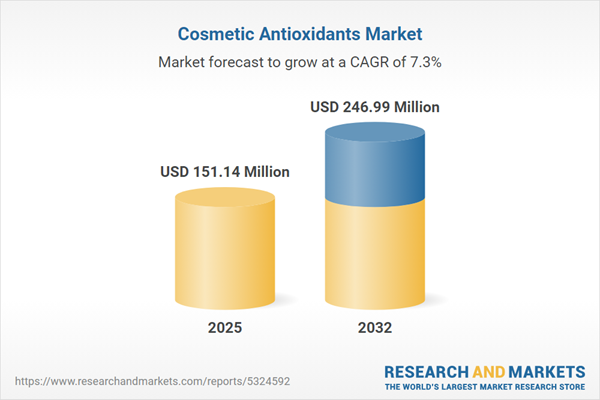Speak directly to the analyst to clarify any post sales queries you may have.
The cosmetic antioxidants market is evolving rapidly as science, consumer preferences, and sustainability trends converge. For senior decision-makers, understanding this dynamic landscape is vital for capturing opportunities, managing risk, and maintaining a strategic edge.
Market Snapshot: Growth Trajectory in Cosmetic Antioxidants
Driven by breakthroughs in ingredient efficacy and intensified demand for advanced skincare, the cosmetic antioxidants market is demonstrating sustained growth. The market expanded from USD 140.98 million in 2024 to USD 151.14 million in 2025, with a steady CAGR of 7.26%. Projections show continued momentum, reaching USD 246.99 million by 2032.
Scope & Segmentation
This report delivers detailed analysis across product types, consumer applications, and competitive landscapes, guiding executives through the multifaceted nature of the cosmetic antioxidants sector.
- Type: Coenzyme Q10, Niacinamide, Resveratrol, Vitamin C, Vitamin E
- Form: Creams & Lotions (Day Creams, Night Creams), Oral Supplements, Powders, Serums (Anti-Aging, Brightening, Hydrating)
- Application: Color Cosmetics, Haircare, Skincare, Sun Care
- Distribution Channel: Offline (Beauty Clinics, Pharmacies, Retail Stores, Spas), Online (Brand Websites, E-Commerce Platforms, Retailer Websites)
- End User: Female, Male, Unisex
- Price Range: Luxury, Mass, Premium
- Regions: Americas (United States, Canada, Mexico, Brazil, Argentina, Chile, Colombia, Peru), Europe, Middle East & Africa (United Kingdom, Germany, France, Russia, Italy, Spain, Netherlands, Sweden, Poland, Switzerland, United Arab Emirates, Saudi Arabia, Qatar, Turkey, Israel, South Africa, Nigeria, Egypt, Kenya), Asia-Pacific (China, India, Japan, Australia, South Korea, Indonesia, Thailand, Malaysia, Singapore, Taiwan)
- Companies Profiled: Amorepacific Corporation, Archer Daniels Midland Company, Ashland Global Holdings Inc., Barentz International B.V., BASF SE, BTSA Biotecnologias Aplicadas S.L., Croda International PLC, Eastman Chemical Company, Evonik Industries AG, Giuliani S.p.A., Kemin Industries, Inc.
Key Takeaways: Strategic Insights for Senior Decision-Makers
- Consumer demand is steering cosmetic antioxidant innovation toward transparency, sustainability, and multifunctional efficacy.
- Brands leverage proprietary blends, advanced encapsulation, and biotech-powered ingredients to gain market distinction.
- Personalization and data-driven engagement enhance consumer loyalty and support premium positioning in both established and emerging markets.
- Agile supply chain strategies and localized partnerships become increasingly important, especially amid shifting cost structures and raw material volatility.
- Regional nuances—such as regulatory harmonization in EMEA and fast-paced product adoption in Asia-Pacific—necessitate targeted approaches for sustained growth.
- Collaboration between R&D, marketing, and procurement is essential to deliver high-impact formulations and achieve compliance across jurisdictions.
Tariff Impact: Navigating Raw Material Cost Shifts
Recent tariff adjustments in the United States have heightened cost pressures for key raw ingredients and specialty delivery systems within the antioxidant segment. Companies are responding by diversifying supplier networks, processing closer to demand centers, and optimizing formulations to minimize exposure to import duty fluctuations. These adaptive strategies are critical for maintaining margin resilience and market accessibility without undermining efficacy or product quality. Pricing sensitivity is a consideration, with premium product consumers generally more tolerant of minor increases, while broader segments require value-focused differentiation.
Methodology & Data Sources
This report draws from primary interviews with industry leaders across R&D, manufacturing, and marketing, supplemented by analysis of scientific literature, trade associations, and regulatory sources. The research framework utilized quantitative market modeling and qualitative scenario assessments, delivering well-rounded, actionable insights for decision-makers.
Why This Report Matters
- Enables informed investment and product development by highlighting technology adoption and evolving consumer expectations.
- Supports risk management and supply chain planning in response to regulatory changes and tariff impacts.
- Provides a competitive roadmap by profiling leading companies and key regional developments across the entire value chain.
Conclusion
Cosmetic antioxidants are reshaping industry standards for efficacy, sustainability, and consumer engagement. Executives who leverage these insights will be positioned to drive strategic growth and lead in an increasingly competitive sector.
Additional Product Information:
- Purchase of this report includes 1 year online access with quarterly updates.
- This report can be updated on request. Please contact our Customer Experience team using the Ask a Question widget on our website.
Table of Contents
3. Executive Summary
4. Market Overview
7. Cumulative Impact of Artificial Intelligence 2025
List of Figures
Samples

LOADING...
Companies Mentioned
The key companies profiled in this Cosmetic Antioxidants market report include:- Amorepacific Corporation
- Archer Daniels Midland Company
- Ashland Global Holdings Inc.
- Barentz International B.V.
- BASF SE
- BTSA Biotecnologias Aplicadas S.L.
- Croda International PLC
- Eastman Chemical Company
- Evonik Industries AG
- Giuliani S.p.A.
- Kemin Industries, Inc.
Table Information
| Report Attribute | Details |
|---|---|
| No. of Pages | 199 |
| Published | October 2025 |
| Forecast Period | 2025 - 2032 |
| Estimated Market Value ( USD | $ 151.14 Million |
| Forecasted Market Value ( USD | $ 246.99 Million |
| Compound Annual Growth Rate | 7.2% |
| Regions Covered | Global |
| No. of Companies Mentioned | 12 |









